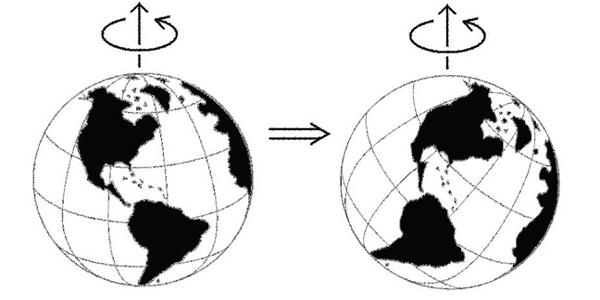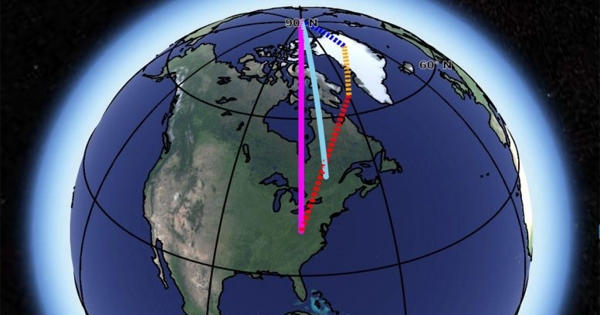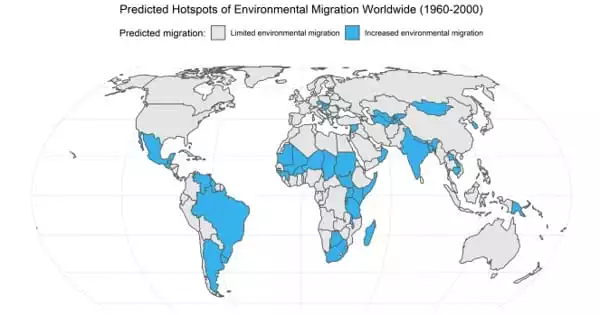The North and South Poles are not fixed, unchanging locations on our planet. The axis around which the Earth spins—or, more specifically, the surface from which the invisible line emerges—is constantly moving due to processes that scientists do not fully comprehend. One factor driving the drift is the distribution of water on the Earth’s surface.
According to a new study published in Geophysical Research Letters, melting glaciers redistributed enough water to cause the direction of polar wander to turn and accelerate eastward during the mid-1990s.
“The faster melting of ice due to global warming was the most likely cause of the directional change of the polar drift in the 1990s,” said Shanshan Deng, a researcher at the Institute of Geographic Sciences and Natural Resources Research at the Chinese Academy of Sciences, the University of the Chinese Academy of Sciences, and one of the study’s authors.
Glacial melting due to global warming is likely the cause of a shift in the movement of the poles that occurred in the 1990s.
According to Vincent Humphrey, a climate scientist at the University of Zurich who was not involved in this research, the Earth spins around an axis like a top. When the weight of a spinning top is changed, the spinning top begins to lean and wobble as its rotational axis shifts. The Earth experiences the same phenomenon as weight shifts from one area to another.
Researchers have been able to determine the causes of polar drifts since 2002, using data from the Gravity Recovery and Climate Experiment (GRACE), a NASA-German Aerospace Center joint mission that launched twin satellites that year and a follow-up mission in 2018. The mission gathered data on how mass is distributed across the planet by measuring uneven changes in gravity at various locations.
Previous research based on GRACE mission data revealed some of the reasons for later changes in course. Recent movements of the North Pole away from Canada and toward Russia, for example, have been linked to factors such as molten iron in the Earth’s outer core, according to research. Other changes were caused in part by the terrestrial water storage change, which is the process by which all of the water on land—including frozen water in glaciers and groundwater stored beneath our continents—is being lost due to melting and groundwater pumping.

The authors of the new study believe that the loss of water on land has contributed to shifts in polar drift over the last two decades by changing the way mass is distributed around the world. They were particularly interested in seeing if it could explain changes that occurred in the mid-1990s. The direction of polar drift shifted from south to east in 1995. The average drift speed from 1995 to 2020 increased approximately 17 times over the average speed recorded from 1981 to 1995.
Researchers have now discovered a way to use modern pole tracking analysis to go back in time and learn why this drift occurred. The new study calculates total land water loss in the 1990s, prior to the launch of the GRACE mission.
“The findings provide a clue for studying past climate-driven polar motion,” said Suxia Liu, a hydrologist at the Chinese Academy of Sciences’ Institute of Geographic Sciences and Natural Resources Research and the corresponding author of the new study. “The goal of this project, which is funded by China’s Ministry of Science and Technology, is to investigate the relationship between water and polar motion.”
Water loss and polar drift
Liu and her colleagues calculated how the water stored on land changed using data on glacier loss and estimates of ground water pumping. They discovered that water loss from polar regions is the primary driver of polar drift, with contributions from water loss in nonpolar regions. All of this water loss explained the eastward shift in polar drift.
“I think it brings an interesting piece of evidence to this question,” said Humphrey. “It tells you how strong this mass change is—it’s so big that it can change the axis of the Earth.” Humphrey said the change to the Earth’s axis isn’t large enough that it would affect daily life. It could change the length of day we experience, but only by milliseconds.
According to Deng, the faster melting of the ice cannot fully explain the shift. While they didn’t look into it specifically, she speculated that the small difference could be due to land water storage activities in non-polar regions, such as unsustainable groundwater pumping for agriculture.
According to Humphrey, this evidence demonstrates how much direct human activity can influence changes in the mass of water on land. Their analysis revealed significant changes in water mass in areas such as California, northern Texas, the Beijing region, and northern India, for example—all of which have been pumping large amounts of groundwater for agricultural use.
“The contribution of ground water is also significant,” Humphrey said. “Here you have a local water management problem that this type of analysis picks up on.” According to Liu, the study has broader implications for our understanding of land water storage in the early twentieth century. Researchers have 176 years of polar drift data. Using some of the methods mentioned by her and her colleagues, it may be possible to estimate how much land water was lost in previous years by analyzing changes in direction and speed.
















